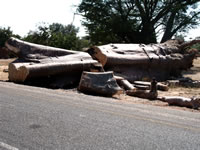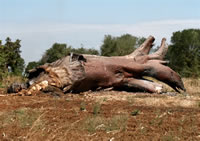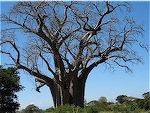State of the Nation – Two Giants have been Struck Down
1st tree pictured on right – This giant Baobab tree fell across the main highway M-14 from Salima to Lilongwe during the rainy season of 2007. It was located 2 kilometers west of the Nkotakota
2nd tree pictured on right – A little farther to the west on the left side of highway M-4 when traveling toward Lilongwe stood another of the ancient Baobab trees. This one stood near a village where the inhabitants used the shelter of the tree to dry cassava leaves. The birds would lodge in the tree and the bird droppings became a problem to the village people. Unable to dislodge the birds and rather than move the drying to a new area the people cut off all of the limbs of the ancient tree.
Both of these landmarks on the road to Salima were hundreds of years old, and in some ways are reflective of the changes that are tugging at the very heart of the nation.
On the one hand, forces beyond their control and from outside of their realm of influence are coming to bear on them. These forces, like the rains that ripped away the tree, are influencing their
The second influence is coming more from within the nation itself. Malawi has the highest population per square kilometer than any other nation in Africa. This is a growing problem and straining all of her resources. Natural resources are being consumed at too fast a pace. Trees are being cut down for firewood at an alarming rate and the forests that once populated the central region are disappearing. Too few trees are being replanted for future use. Alternative energy life styles will be necessary for survival in a very short time, yet there does not appear to be viable options on the horizon that will be easily adopted in this patterned, traditional culture. Electricity and good water are in short supply and the infrastructure is not prepared to handle the rapidly increasing needs. The capital city of Lilongwe has doubled in population during the time the nation was only realizing a 10 to 15% growth. The people are moving rapidly from their rural, village, traditional culture into the cities, and there are not enough jobs to support them. Poverty is growing, job creation is lagging, crime is on the increase, and the medical system for the county continues to go backwards as less than 100 Malawi doctors, and only 2,400 nurses remain in the practice to care for a population of nearly 13 million people. HIV/Aids, drug resistant TB, Malaria, pneumonia, diarrhea and a number of other diseases are on the increase, and the life expectancy is going down from a high of 54 to a low that is anticipated to be nearing 37. There are not enough supplies, not enough equipment, not enough doctors and not enough nurses.
But Good Things Are Also Happening
However not everything is bleak. Like the prosperous and successful 3rd tree pictured on the right there are many things in Malawi that offer a positive and growing future. The happiness
Trees Reflect The Nation
In many ways the future of Malawi may be reflected in the Baobab trees on the road to Salima. Pressure is coming to bear on Malawi from within and without, and some of the pressures are bringing rains of change that could eat away at the root system of the past. With change can come changes that topple the structure. These winds are brining challenges that have never been faced before. They will bring transformation that cannot be rolled back. The inability to accept and adopt change that is necessary for survival.
The roots of the nation and its tribal traditions run deep and stand on a relatively solid footing, but change is battering the tree. Some of the outside influences will release toxic droppings on the very life of the nation they are trying to help, while others will come in and extend a step-up into a new and better future.
One should not mistake the scene along M-14 near Salima. There are still large numbers of beautiful baobab trees standing strong, tall and undisturbed by the forces that come to bear down on them. And like these trees of the ancient past the nation of Malawi and its successful tribal alliances have weathered many storms and are still standing.

